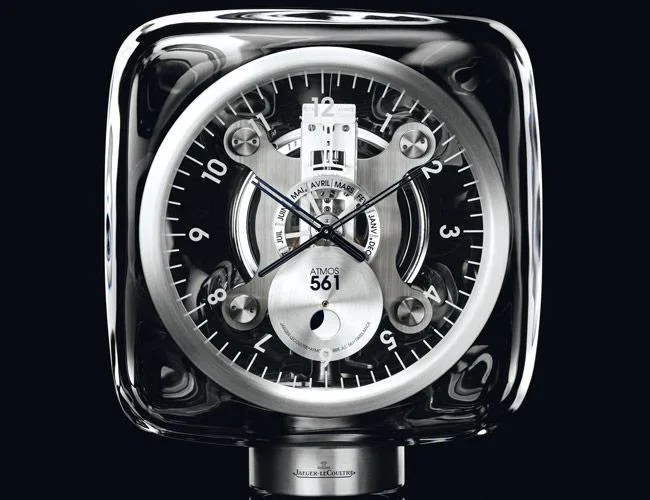We like to think our self-winding watches can run forever. But they will stop eventually, and before then their accuracy will degrade. Friction, viscosity, air resistance, not to mention entropy buildup — the Second Law of Thermodynamics and all that — conspire against the mechanical timepiece. The sad fact is, perpetual motion is physically impossible. But with a little maintenance here and there, it’s almost achievable. The Jaeger-LeCoultre Atmos clock, invented in the 1920s, is “living” proof. How does it do it? The key is something that’s constantly changing, even though we often can’t tell: temperature.
MORE ICONS OF TIMEKEEPING Audemars Piguet Royal Oak | Jaeger-LeCoultre Reverso | The Valjoux 7750 Chronograph
Today’s Atmos, like its predecessors, bypasses the pesky business of hand- or auto-winding a mainspring by making use of thermal expansion and contraction, the physical principle that materials will expand and contract with changes in temperature. The Atmos takes maximum advantage of this principle by using substances that are extremely sensitive to such changes; in the modern Atmos, that means a bellows filled with ethyl chloride. Its expansion and contraction drives a mechanism that winds the mainspring. Friction is minimized everywhere in the Atmos movement, and the torsional pendulum only beats twice a minute. This means it can run (almost) indefinitely as long as very small changes in temperature (one or two degrees Fahrenheit) actually take place.
That all sounds incredibly innovative, but the principle has been around a long time. The first clocks based on temperature changes were made nearly 400 years ago. The oldest one still running today, the Beverly Clock, was built in 1864. It has not been manually wound from that day to this. Instead, its mechanism is driven by variations in atmospheric pressure and daily temperature fluctuations. Jean-Léon Reutter, an engineer in Neuchâtel, Switzerland, took note of these earlier timepieces and designed the first Atmos clock in 1928. The mechanism that drove this early version, not yet named Atmos (but now called “Atmos 0” by clock intelligentsia), was powered by a module made of glass and mercury and operated solely due to variations in temperature (barometric pressure need not apply). The first commercial version, the Atmos 1, was first produced in 1929 by the French company Compagnie Générale de Radio (CGR). This model used a bellows filled with mercury and ammonia, which today would be considered a major safety hazard, to drive the movement.
The oldest clock using thermal expansion and contraction and still running today, the Beverly Clock, was built in 1864. It has not been manually wound from that day to this.
The Swiss firm LeCoultre entered the picture in 1932, agreeing to develop and produce the Atmos 1 for CGR. They delivered 1,000-2,000 clocks in 1933 and 1934. In mid-1935 LeCoultre took over all production. At the same time, they began development of a next-generation Atmos, this time to be powered by ethyl chloride — the substance still in use in the bellows of Atmos clocks produced today. The new Atmos II was announced in 1936, but production problems intervened and the clock was not released for public sales until the middle of 1939. The Atmos II and III were produced until late 1955; the Atmos IV’s production run was only 10,000 units, the shortest of all the generations of the clock.
Generations V, VI, VII, and VIII are mainly distinguished by the clock calibers they contained. However, some generations used multiple calibers, and some calibers span two or three generations. Additionally, serial numbers intertwine between the generations, but there is good documentation should you be interested in determining more about your own Atmos, should you be lucky enough to own one.

